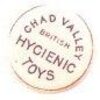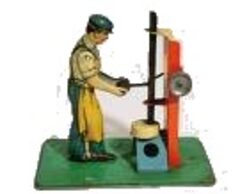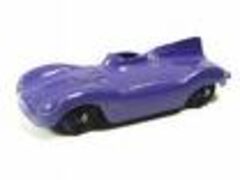
History Of Tin Toys C-D
 |
Chad Valley Toy CompanyThe Chad Valley Toy Company had its origins in a printing and bookbinding business that was set up in Birmingham by Anthony Bunn Johnson. Very little is known about this firm, but an original letterhead dated 1850, claims that it had already been established upwards of thirty years. A small stream, the Chad, flowed close by the new factory and it soon aquired the name of The Chad Valley Works, from which the registered trade mark "Chad Valley" is derived. With the outbreak of the First World War in 1914 the imports of toys and games into this country stopped. Despite restrictions of material and available personnel Chad Valley used this opportunity to increase its range of products and to expand. The company produced its first soft toys, a range of traditional, jointed, plush Teddy Bears in 1915. By the early 1930's they were advertising a range of bears in fourteen different sizes. 1920's - 30's bears were marked with a printed, celluloid-covered, metal button and/or woven label. Source Fab Tin Toys More History http://www.madeinbirmingham.org/chadvalley.htm
|
  |
J. Chein & Co NY City and Harrison, New Jersey, 1903 - 1979 The company began in a loft in New York City in 1903. with a metal-stamping operation run by Julius Chein. The company produced small tin prizes for the Cracker Jack boxes and other small toys for five and dime stores. Although the Chein Company made the advertising tins that we collect in its later years, its reputation is built on the nostalgic tin toys and tin banks that are so collectible.
|
  |
Corgi Corgi Toys first appeared in July 1956, manufactured by Mettoy Playcraft Ltd. in Swansea, Wales, as direct competition to Meccano's Dinky Toys model vehicles, which had dominated the British toy car market for many years. |
 | Cragston was a U.S.-based toy marketing and distribution firm that specialized in importing mechanical and battery-operated toys made in post-war Japan. The company focused on toys with multiple actions and made sure its company name appeared on the highly decorated boxes in which they were sold. It is believed that the company's name was derived from a combination of the owners' names. They continued to operate through the mid -1960s. The toys manufactured by this company are more sophisticated and detailed than the battery-operated toys made by other companies. A combination of factors--the more complicated actions of the toys, the attention to costuming detail, and the fine lithography on the toys and boxes-help set this company apart from the rest.
|
 | 1917 saw the first mass produced pedal car manufactured by a company called Cyclops. Before this time Australian children had to rely on mostly imported pedal cars, mainly from the English firm Lines Bros. There were of course pedal cars available in the "Do it yourself form" or by small independent companies. Cyclops rapidly progressed into a Australia's largest Pedal Car Manufacturer, and by the 1930's were joined by another company "Peerless" By the late 1940's Cyclops and Peerless were household names and with the demise of the Peerless company in 1951, Cyclops virtually had the monopoly on Pedal cars, scooters and the ever reliable Dinky. It was during the 50's until the 70's that made Cyclops an Australian icon, for ask any child from any era, and they will say they grew up with a Cyclops! |
  |
Johann DistlerNuremberg, Germany, 1900 - 1968. |
  |
Dowst (Tootsietoy) Tootsie toys is a manufacturer of die cast toy cars and other toy vehicles. The company, that would later become known as Tootise toys, made their debut in 1906 when a Chicago based company, Dowst Brothers, made a miniature die cast toy of a Model T Ford. By the early 1920s the name 'tootsie' was being used as a brand name. The 'Tootsie' moniker apparently came from one of the Dowst Brothers' granddaughters, whose name was "Toots". Tootsie toys are produced in Chicago, and were also previously produced in nearby areas such as Rockford, Illinois. Many tootsie toy cars are still made from a die cast mold, with a solid metal axle connecting the wheels to the metal body. Tootise toys, which is now owned by the Strombecker corporation and still based in Chicago, makes about 40 million cars per year. |

Dinky Toys are die-cast miniature model cars and trucks. They first appeared in early 1934 when Meccano Ltd of Liverpool, England introduced a new line of "modelled miniatures" under the trade mark "Meccano Dinky Toys". The first announcement for the new line was made in the April 1934 issue of Meccano Magazine .
In the early 1950s a Dinky Toy craze hit the United Kingdom and it seemed that all boys (and some adults) had collections. Their dual role as toy and model had no peers at the time. Most of the models were in a scale of approximately 1:48, which blended in with O scale railway sets, but many buses and lorries (trucks) were scaled down further so that they were around 4 inches long. Larger models (Dinky Super Toys) were not scaled down, and started to have more action features. Notable favourites are the Coles Mobile Crane and the Horse Box (with opening doors). In 1954 , the Dinky line was reorganized: cars were now sold in individual boxes, and there were no series of models differentiated by a letter. A separate line of models were also made in France . Both English and French Dinky Toys were exported to the United States .

